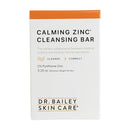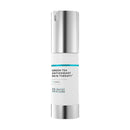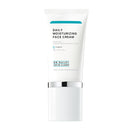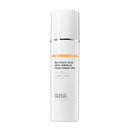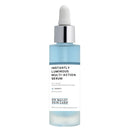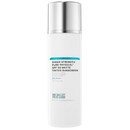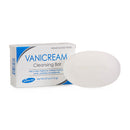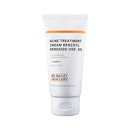What's the Best Skin Care to Fade Sunspots?

Everyone with skin sunspots wants to know what's the best skin care to fade their sunspots. These brown spots remind us of looking at our parents or grandparents. No matter how much we love our family, we sort of hope that we won't have their mottled spotty skin as we age. But it takes work.
There are three main types of skin care products to control, lighten, and get rid of sunspots. Use them all and you will get the best results.
Best Skin Care to Fade Sunspots
Your three main types of products to fade sunspots should include:
- Exfoliating products that remove existing skin pigment in your sunspots.
- Products that turn down or alter skin pigment production to help prevent future darkening of your sunspots.
- Broad spectrum sunscreens that block the UV rays that are the cause of these annoying sunspots in the first place.
In my dermatology practice, when I create a skin care routine for my patients who want to control their sunspots, I usually incorporate all of these types of skin care products into a comprehensive and powerful skin care routine. Their skin also looks younger and is softer because these products provide those benefits too! Below are the details of how we do this.
3 skin care steps dermatologist's use to fade sunspots on skin.
Step 1. Exfoliate to fade sunspots.
Exfoliating skin care will help lighten your sunspots because the pigment of the spots is carried up from the living cells into the dead cells above. Exfoliating removes the dead cells - pigment and all!
Exfoliation isn't just about using a rough skin scrub or shower sponge though. The best exfoliation comes when you use both physical exfoliation and “chemical” exfoliation to do the job.
You are probably familiar with “physical” exfoliation. This is the use of rough sponges or scrubs to remove the outer dead cells on your skin. “Chemical” exfoliation is more complicated. This is the use of creams like AHAs and BHAs to loosen the glue that holds the dead cells onto your skin. When you loosen the “glue” the cells come off better, giving you even greater results. My favorite way to do this is with the combination of products in my Ultra-Fast Triple Action Body Skin Smoothing AHA Kit and my Glycolic Acid Anti-Wrinkle Facial Cream. It's why I made the kits in the first place. I've used them for years on my own skin. My patients and I are testaments to how well they work.
My Glycolic Acid cream and kits are complete physical and chemical exfoliation skin care routines - and they work for sunspots!
It really works for age spots! I've used it for 2 weeks, not every day. I put it on one of my hands too and that one has less age spots now than the other.” RAM
This combo of strong AHA and physical exfoliation means that the routine will loosen the glue which holds dead cell together on top of sun spots. Then the rough sponges and cloth help remove the loose cells with just the right amount of physical exfoliation and the glycolic acid cleanser.
Dead skin cells and the pigment in sunspots are sloughed and polished and your skin takes on a dewy, youthful, and more even luster. Wear a broad-spectrum sunscreen during the day and you’re set for some of the best anti-aging skin care to fight your brown and unwanted sunspots. - Dermatologist Dr. Cynthia Bailey
Step 2. Add skin pigment faders to your skin care routine to help lighten your sunspots even more.
Faders are products that actually decrease the amount of pigment produced by your pigment-producing melanocyte skin cells or they prevent it from getting spread out in the skin unevenly.
Melanocytes are the pigment making cells in your skin. In sunspots, the melanin is too dense in the spot compared with the rest of your skin. Along with avoiding the UV rays that stimulate pigment production in the first place, you can also use specific ingredients to turn down and change the skin's biochemical steps of pigment production and distribution even more. The best product options to do this include:
Retinoids
These include retinol products like my Retinol Intensive Night Cream with the strongest retinol levels available without a prescription. They also include prescription retinoids like tretinoin (Retin A) and Tazorac. Retinoids also exfoliate skin so you are getting a two-fer in terms of how they will help lighten sunspots. Additionally, they are powerful collagen-production stimulators, which means they help reduce wrinkles and other signs of skin aging.
If you are unfamiliar with retinoids and retinol to fade sunspots click here to see why retinoids are such an important part of the best anti-aging skin care routines.
I absolutely love all your products, my skin feels so refreshed and looks healthy. I have barnacles and age spots that are diminishing. ... Thank you for your products. Linda
Vitamin C
Adding a skin care product with high concentrations of stable vitamin C can help to turn down pigment production by blocking the tyrosinase enzyme that is essential for melanin synthesis in your skin. This helps lighten sunspots. The effect is mild, but vitamin C products potentially have other anti-aging benefits, such as the ability to stimulate collagen formation and act as an antioxidant to neutralize damaging free radicals.
Vitamin C products are tricky and usually disappointing, however. The key is to find a vitamin C serum formulated to a high concentration and with a very acid pH. It also needs to be dispensed in an airtight container. I actually don't know of any product that meets these criteria. In the past, I had a vitamin C serum that did, but I discontinued it because glycolic acid and retinol work so much better for pigment and collagen formation and green tea is a better antioxidant. I wanted to encourage people to focus on these powerful and proven ingredients. That said, if you have a vitamin C serum you like, it may have some marginal benefit in fighting skin pigment problems.
Hydroquinone
This is the classic proven medicine “skin bleaching” ingredient in skin lightening creams and lotions. You can get excellent results with 2% hydroquinone that is available without a prescription in my Pigment Fading Pads. I combine hydroquinone with other tyrosinase enzyme blockers for maximal results. Use hydroquinone for 3 to 4 months to tackle tough sunspots.
For best results, hydroquinone should be used in combination with retinoids, AHAs (like glycolic acid), and broad spectrum SPF 30+ sunscreen. For many years, the old Obagi NuDerm kit was the most effective combination skin care routine to lighten these age spots. In my dermatology practice we would use a 4-month session of Obagi NuDerm in the fall to improve the sunspots (aka solar lentigines) that inevitably worsen during the summer. The product formulations needed updating to modern standards though and I no longer use this product line.
Now we use my Ultimate Pigment and Sun Damage Repair Kit. It contains all the products you need to lighten facial sunspots, rejuvenate and brighten your skin - including my Pigment Fading Pads. Use the kit for 4 months then discontinue adding the hydroquinone to the Pigment Fading Pads. The other products in the routine are ideal for your permanent anti-aging and pigment controlling skin care routine.
I got the pigment fading pads as a part of the pigment and sun damage kit and this stuff really works! With very consistent use (I make an effort to use it EVERY night!) the dark sun damage on my forehead and cheeks faded A LOT in just a matter of weeks. It's definitely worth it! Lisa
What are some of the non-hydroquinone skin lighteners to fight sun spots?
There are other skin lighteners, such as kojic acid, azelaic acid, licorice, and arbutin that can be used in skin care products to lighten solar lentigines. I find that they don’t work quite as well as hydroquinone. They work best when combined with sunscreen, a retinoid, and/or an AHA such as glycolic acid. Some of these botanical lighteners are included in my Pigment Fading Pads.
Step 3. Wear Broad Spectrum Sunscreen Every Day!

Sun up to sun down, 365 days a year, on the entire planet earth, UV rays will create and darken your sunspots. Yep, your sunspots are not safe in winter, on the North Pole, at dawn, or at dusk. It's true that at those times and places the UVB sunburn ray is weaker. However, the UVA ray is out as intensely as it is at 12 noon on the equator, and UVA darkens sunspots! It means you need to wear a broad spectrum sunscreen all year during the daylight hours. Put it on your face and all exposed skin when you get ready for your day in the morning. For intense exposure, reapply it as directed. Pick a product with 5% or more zinc oxide listed as an active ingredient for trusted UVA protection. Click here for the broad spectrum zinc oxide sunscreens that I trust.
Don't miss the other 3 articles in this dermatology series on sun spots - cause and cure:
Post 1. What Causes Sunspots on Skin?
Post 2. How to Get Rid of (Prevent) Skin Sun Spots
Post 3. What Are the Best Skin Care Products to Fade Sun Spots? (This article)
Post 4. How to Get Rid of Those Pesky Sunspots (With Procedures!)


